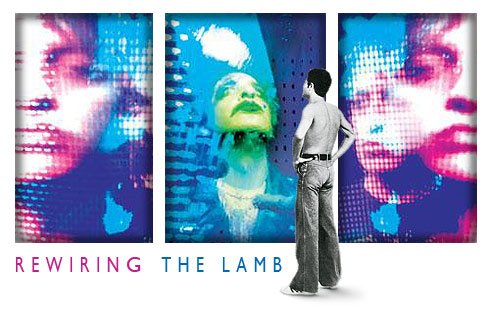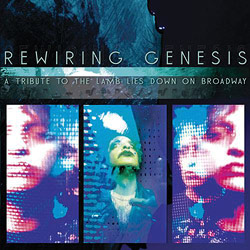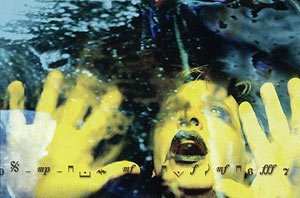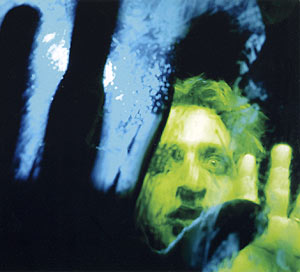


The background of this project will not be discussed here as it is presented better in the interview with Nick d’Virgilio. Neither will you find anything about the composition here because it is basically identical with the original.
It takes a lot of self-confidence to tackle a project like this. You have to know your craft, and you must not be afraid of being compared to the renowned original, for though there is no official sheet music all connoisseurs know exactly how The Lamb Lies Down On Broadway has to sound!
Rewiring Genesis is very accomplished. The recording resolves the opposition of faithful reproduction and new interpretation: The musicians play the original music very precisely – and still manage to sound completely different.
The reason for this are the instruments used and the way they were arranged. On Rewiring Genesis, neither keyboards nor synthesizers are used; instead we get to hear a brass group of seven and a string quintet. They lend an acoustic, earthy dimension to the clear and lively sound of the music.
 The skills of everybody involved, be they producers or executing musicians, are evident throughout. The music has been brilliantly arranged to bring out the best in the instruments employed – and it is a pleasure to hear the soulful interpretations, particularly if you bear in mind that, coming from jazz, blues and classical music, none of the musicians in the brass and string groups knew The Lamb beforehand.
The skills of everybody involved, be they producers or executing musicians, are evident throughout. The music has been brilliantly arranged to bring out the best in the instruments employed – and it is a pleasure to hear the soulful interpretations, particularly if you bear in mind that, coming from jazz, blues and classical music, none of the musicians in the brass and string groups knew The Lamb beforehand.
It is obvious that the musicians are American. They become the music very well, though the rainy mood of the British original is very appealing, too. The original melancholy is tinged with the blues here. And where there was orchestral scope of almost classical dimensions there is now a splendid big band ensemble.
Despite all the “innovations” the new recording reaffirms the strengths of the original composition, the more so since it was not changed at all. Fly On A Windshield still gives you goose bumps and the unruly power of In The Cage is overwhelming. The new interpretation proves the genius of the original.
The Lamb Lies Down On Broadway
The intro on the classical piano shows how close Rewiring Genesis is to the original. It will be difficult to suppress a chuckle at the cheeky big band that joins in the music. The bass and guitar lines are taken over by the brass section. This song does what it is supposed to do, it takes you to Broadway Boulevard. Wonderful!
Fly On A Windshield / Broadway Melody Of 1974
Close to the original, the song does not lack the explosive force of the famous scene. Nick’s voice, alas, does not provide the emotional depth Peter Gabriel managed to convey. His drumming, however, deserves the highest praise. It is inspiring to see how he does not simply copy Phil’s style of playing but enriches it. The brass group take a break while the string section produces a very consistent mood.
Cuckoo Cocoon
An acoustic guitar with steel strings and a flute, that is all that is needed to perform Cuckoo Cocoon. Nick’s vocals make it sound like a singer/songwriter piece. Pity the metallophone was left out.
In The Cage
The song stays true to the original, only the keyboard and sometimes the guitar parts, too, are played by the wind and string ensembles.
 The Grand Parade Of Lifeless Packaging
The Grand Parade Of Lifeless Packaging
This is basically an a capella piece. All instrument lines are taken over by voices, accompanied only by drums and percussions.
Back In N.Y.C.
Some songs on the album are faithful to the original, while others seem almost eccentric with their new instrumentation. The latter is the case with Back In N.Y.C. The wind instruments take over the keyboard line which gives the song a big band feel. Muted trumpets in the bridge (“as I cuddled…”) are reminiscent of West Side Story. “Off we go” is totally weird because folk music brass instruments are forced into the weird time signature.
Hairless Heart
A completely new interpretation. Hairless Heart is presented like bar jazz with the piano taking over the guitar melody. No wind instruments here, but the strings accompany the tune.
Counting Out Time
… begins with a typical big band sound and suddenly erupts into lively Dixieland jazz! Nick’s vocals may remind you of David Lee Roth.
Carpet Crawlers
Fortunately there are none of the eccentricities mentioned before. Carpet Crawlers is presented in a very tasteful manner. Piano and strings bring in a very warm, natural sound. Amazing how close the vocals are to Peter’s in the intro.
The Chamber Of 32 Doors
Don Carr's first opportunity to demonstrate skill at playing the lead guitar. The song remains close to the original. The natural sound is carried mainly by a dry bass sound.
Lillywhite Lilith
Again, close to the original. No wind instruments, and the string group can be heard only at the end.
The Waiting Room
The large number of instruments used in recording Genesis Rewired is ideal for The Waiting Room. Still, an envelope filter was used for the cat-like whining sounds, which is all the more remarkable since the album does without synthesizers.
Anyway
The string quintet creates a wonderfully natural atmosphere again.
Here Comes The Supernatural Anaesthetist
Here comes the super-competent lead guitarist! Changing guitar sounds are brought to a peak at 1’38. A pitch transposer doubles the lead guitar with a quint and thus produces a sound that resembles Brian May’s. Accentuated guitar playing shows how great the original music is.
 The Lamia
The Lamia
A steel-strung acoustic guitar, an e-piano and an impressive choir of female voices carry this piece. The Lamia is aptly sung by a woman. No wind or string instruments here.
Silent Sorrow In Empty Boats / intro to The Colony Of Slippermen / Ravine
The use of natural instruments like strings and flute is most delightful in these small interludes.
The Colony Of Slippermen
Another song that has become extraordinary, even bizarre by the instruments used in the new recording. A groovy piano rules in the verses with interspersed wind instrument cues. The bridge is played on the accordion. In the middle of the song a big band groove develops that is carried mainly by the walking bass. The striking Moog solo is also played on the accordion.
The Light Dies Down On Broadway
The intro is played on the accordion again, while the flute takes over the part that is played on the mellotron in the original. The whole song thrives on the string ensemble and choirs.
Riding The Scree
Very lively drumming, groovy brass and a virtuoso clarinet showcase the musicians’ tremendous skills.
In The Rapids
The original is carried by Gabriel’s voice. Nick brings his very own, American way of singing to bear on the melody.
it
The record ends as it began. Once more you get the impression that you have just seen a musical on Broadway. It seems like the end of a grand chorus line with splendid trumpet fanfares and extroverted American entertainment.
Think what you will about the new interpretation, but we feel certain that you will be won over by the ambitious, competent performance of all the musicians. The rainy mood of the original is gone, and so is the tristesse of the overall sound, but all in all Nick and Mark have proved the compositional quality of the original.
by Robert Krauskopf
translated by Martin Klinkhardt




Some say it is one of the best Live-Albums ever. Genesis' Seconds Out became a milestone and also marked the end of the classic years.